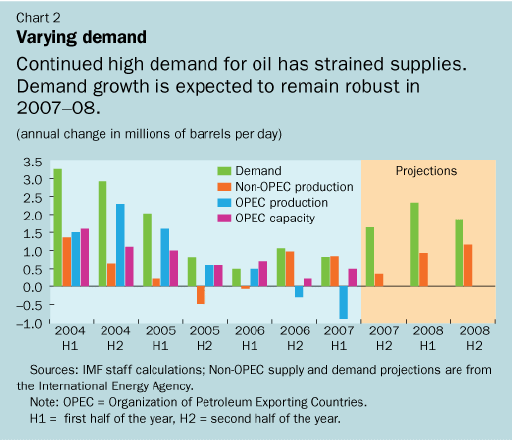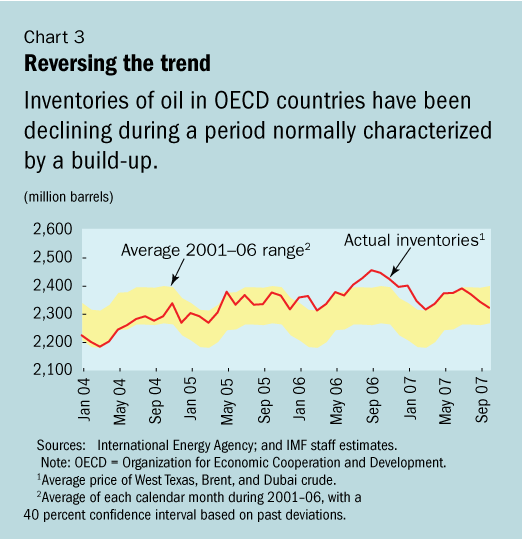High Oil Prices Challenge Policymakers
Location: New York
Author:
RiskCenter Staff
Date: Tuesday, November 27, 2007
- Geopolitical risk, disrupted supply, weak dollar, capacity limits are influences
- Could boost inflation, roil monetary policy, hit low-income countries
- Further price shocks could have significant negative impact on growth
With oil prices heading toward $100 a barrel, the rise in energy costs is a new worry for consumers at a time of continued concerns in major economies about fallout from the credit crunch.
The average petroleum spot price (APSP) reached a new high of over $93 on November 7. The three main benchmark prices for oil all reached record highs around the same time, with West Texas Intermediate closing at almost $97, Brent at $94, and Dubai at almost $89.
But not everyone is receiving the same pinch from the oil price hike. Measured in euro and Special Drawing Right (SDR) terms, the surge has not been as dramatic, reflecting the depreciation of the dollar, the currency that oil producers are paid in (see Chart 1). The effects of the depreciating dollar on the price of oil was discussed at the third summit of the Organization of the Petroleum Exporting Countries (OPEC), held November 17-18.
As of mid-November, futures and options markets indicate that the APSP will average almost $88 per barrel in the fourth quarter of 2007 and almost $87 in 2008, with a more than one in four chance that Brent crude prices could be above $100 by early 2008.

The recent oil price surge was sparked by geopolitical concerns about growing tensions in the Middle East and some weather-related production shutdowns, underscoring that in an environment of limited spare oil production capacity and declining inventories, prices have become highly sensitive to news that may indicate possible future supply shortages. The weakening dollar also played a role. But more fundamentally, spare capacity remains low and market conditions are expected to remain very tight.
Oil demand growth has remained robust, supported by strong growth in emerging markets, particularly China and the Middle East (see Chart 2). While the International Energy Agency recently revised oil demand downward in the fourth quarter of 2007 because of the slowing U.S. economy, global demand is expected to remain strong in 2008.

In contrast, supply has lagged behind and inventories are falling. During the first nine months of 2007, world oil supply declined moderately by 0.1 millions of barrels per day (year on year), reflecting a decline in OPEC's output and limited output growth in oil-producing countries that are not members of OPEC. As a result, commercial inventories in OECD countries fell in the third quarter and October, a period normally marked by inventory accumulation (see Chart 3).

Supply is lagging demand growth because of the increasing technological and economic challenges for oil production. As a result, tight market conditions are expected to persist and possibly intensify, assuming strong GDP growth continues in emerging markets such as China and India.
Analysis by the IMF shows that, over time, a prolonged price surge will certainly have the effect of curtailing demand—especially in the United States—by inducing greater substitution into other energy sources and by increasing incentives to conserve energy. But in the short term, demand may be insensitive to price changes.
The oil price surge is not an isolated event. Many other commodities—including precious metals; industrial metals such as lead and nickel; and foods such as wheat, soybean oil, and palm oil—have all set record highs during 2007. The depreciation of the dollar has amplified the oil price surge in dollar terms. While the APSP rose by almost 51 percent in dollar terms during the year (as of mid-November 2007), it rose only by about 37 percent in euro terms.
Apart from this "accounting effect," some market analysts suggest that the weakening of the dollar, combined with financial turbulence linked to the subprime mortgage market in the United States, may have induced investors to diversify away from dollar-denominated financial assets toward commodities as alternative assets.
High oil prices have not so far had much of an impact on global activity and inflation. The limited impact reflects the demand-driven nature of the runup in oil prices since 2002, as well as lower energy intensity, more competitive labor markets, and the improved credibility of monetary policy frameworks. For developing countries in particular, strong global growth and the rise in nonfuel commodity prices have mitigated the impact of higher oil prices on many countries' trade balances.
That said, the recent oil price surge will likely boost headline inflation in the months ahead (headline or total inflation includes volatile food and energy price components whereas core inflation typically excludes these volatile items). The direct effect of the recent oil price rise on headline inflation in the United States is estimated to be around ½ percentage point by the end of the year.
The impact in other advanced economies will likely be smaller because reliance on private transportation is lower, and because prices have risen less in other currencies. However, central banks may find that they have less room for maneuver in responding to weakening demand caused by the recent financial turbulence, given that higher fuel costs could have second-round effects on other prices and on wages.
The situation is particularly challenging in some emerging market and developing countries where overheating pressures are of greater concern, and rising fuel and food costs may put pressure on household budgets and external balances. In particular, for many low-income oil-importing countries, the recent oil price increase will raise their import bill and could put strain on fiscal positions.
Looking ahead, with market conditions so tight, any significant supply disruption could push prices higher still. In particular, spare production capacity remains below its historical comfort zone, and the majority of it is sour crude from Saudi Arabia, which is difficult to refine into the low-sulfur distillates demanded by OECD countries.
According to most oil market forecasters, this situation is not likely to improve anytime soon, as limited new exploration opportunities will constrain supply. Assuming that strong GDP growth continues in the emerging market countries, high and volatile oil prices could accordingly become the norm for some time.

To subscribe or visit go to: http://www.riskcenter.com